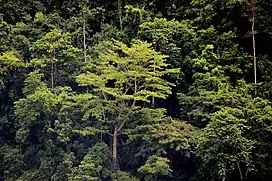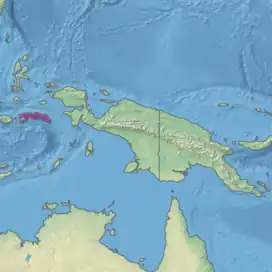Seram rain forests
The Seram rain forests is a tropical moist forest ecoregion in Indonesia. The ecoregion includes the island of Seram and neighboring islands.
| Seram rain forests | |
|---|---|
 Rain forest near Olas, Seram | |
 Ecoregion territory (in purple) | |
| Ecology | |
| Realm | Australasian realm |
| Biome | tropical and subtropical moist broadleaf forests |
| Geography | |
| Area | 18,989 km2 (7,332 sq mi) |
| Countries | Indonesia |
| Province | Maluku |
| Coordinates | 3.13°S 129.5°E |
| Conservation | |
| Conservation status | Relatively stable/intact |
| Protected | 2,000 km²%[1] |
Geography
Seram is the largest island in the ecoregion, with an area of 17,100 km2 (6,600 sq mi). The ecoregion includes several neighboring smaller islands, including Ambon, Haruku, Saparua, and Manipa south and west of Seram, and the Gorong archipelago to the southeast. The islands are mountainous, and Mount Binaiya (3,027 meters) on Seram is the highest point.
The islands that make up the ecoregion are part of Wallacea, a group of islands that are part of the Australasian realm, but were never joined to either the Australian or Asian continents. The islands of Wallacea are home to a mix of plants and animals from both terrestrial realms, and have many unique species that evolved in isolation.[2] The Seram Sea bounds the ecoregion on the north and east, and the Banda Sea lies to the south. Lydekker's Line runs through the Seram Sea; the line demarcates the islands of Wallacea from the islands on the Australia-New Guinea continental shelf which were joined together during the ice ages when sea levels were lower.
Climate
The ecoregion has a tropical rain forest climate.
Flora
The main plant communities are tropical lowland evergreen rain forest, semi-evergreen rain forest, and montane rain forest.[2]
Fauna
The ecoregion is home to 38 mammal species.[2] Six species are endemic to the ecoregion: the Seram bandicoot (Rhynchomeles prattorum), Spiny Ceram rat (Rattus feliceus), Dusky mosaic-tailed rat (Melomys aerosus), Dusky mosaic-tailed rat (Melomys fraterculus), Ceram rat (Nesoromys ceramicus), and possibly the Silvery flying fox (Pteropus argentatus).
The ecoregion is home to 213 bird species. 16 species are endemic to the ecoregion.[2] The ecoregion corresponds to the Seram endemic bird area.[3] The largest bird in the ecoregion is the flightless southern cassowary (Casuarius casuarius).[4]
Protected areas
A 2017 assessment found that 2,000 km2 (770 sq mi), or 11 percent, of the ecoregion consists of protected areas. Approximately three-quarters of the unprotected area is still forested.[1] Protected areas include Manusela National Park on Seram.
External links
- "Seram rain forests". Terrestrial Ecoregions. World Wildlife Fund.
- Seram endemic bird area (Birdlife International)
References
- Eric Dinerstein, David Olson, et al. (2017). An Ecoregion-Based Approach to Protecting Half the Terrestrial Realm, BioScience, Volume 67, Issue 6, June 2017, Pages 534–545; Supplemental material 2 table S1b.
- Wikramanayake, Eric; Dinerstein, Eric; Loucks, Colby J.; et al. (2001-12-01), Terrestrial Ecoregions of the Indo-Pacific: a Conservation Assessment, Washington, DC: Island Press, ISBN 978-1559639231
- BirdLife International (2020) Endemic Bird Areas factsheet: Seram. Downloaded from http://www.birdlife.org on 21/05/2020.
- BirdLife International. 2018. Casuarius casuarius. The IUCN Red List of Threatened Species 2018: e.T22678108A131902050. https://dx.doi.org/10.2305/IUCN.UK.2018-2.RLTS.T22678108A131902050.en. Downloaded on 09 June 2020.